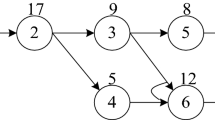Abstract
Product disassembly takes place in remanufacturing, recycling, and disposal. The disassembly line is the best choice for automated disassembly, so it is essential that it be designed and balanced to work efficiently. The multi-objective disassembly line balancing problem seeks to find a disassembly sequence which provides a feasible disassembly sequence, minimizes the number of workstations, minimizes idle time, balances the line (ensures similar idle times at each workstation), as well as addressing other disassembly-specific concerns. However, finding the optimal balance is computationally intensive due to exponential growth, with exhaustive search quickly becoming prohibitively large. In this paper, an ant colony optimization metaheuristic is presented for obtaining optimal or near-optimal solutions to the disassembly line balancing problem. Examples are considered to illustrate implementation of the methodology. Conclusions drawn include the consistent generation of near-optimal solutions, the ability to preserve precedence, the superior speed of the metaheuristic, and its practicality due to its ease of implementation.
Similar content being viewed by others
References
Dorigo M, Di Caro G (1999) The ant colony optimization meta-heuristic. In: Corne D et al (eds) New ideas in optimization. McGraw-Hill, Maidenhead, UK, pp 11–32
Brennan L, Gupta SM, Taleb KN (1994) Operations planning issues in an assembly/disassembly environment. Int J Oper Prod Plan 14(9):57–67
Gupta SM, Taleb KN (1994) Scheduling disassembly. Int J Prod Res 32:1857–1866
Torres F, Gil P, Puente ST, Pomares J, Aracil R (2004) Automatic PC disassembly for component recovery. Int J Adv Manuf Technol 23(1–2):39–46
Gungor A, Gupta SM (1999) Disassembly line balancing. Proceedings of the 1999 annual meeting of the Northeast Decision Sciences Institute, Newport, Rhode Island, March 24–26, pp 193–195
Gungor A, Gupta SM (1999) A systematic solution approach to the disassembly line balancing problem. Proceedings of the 25th international conference on computers and industrial engineering, New Orleans, Louisiana, March 29–April 1, pp 70–73
Gungor A, Gupta SM (2002) Disassembly line in product recovery. Int J Prod Res 40(11):2569–2589
Gungor A, Gupta SM (2001) A solution approach to the disassembly line problem in the presence of task failures. Int J Prod Res 39(7):1427–1467
Gungor A, Gupta SM (1999) Issues in environmentally conscious manufacturing and product recovery: a survey. Comput Ind Eng 36(4):811–853
Lambert AJD (2003) Disassembly sequencing: a survey. Int J Prod Res 41(16):3721–3759
McGovern SM, Gupta SM, Kamarthi SV (2003) Solving disassembly sequence planning problems using combinatorial optimization. Proceedings of the 2003 Northeast Decision Sciences Institute Conference, Providence, Rhode Island, March 27–29, pp 178–180
McGovern SM, Gupta SM (2004) Demanufacturing strategy based upon metaheuristics. Proceedings of the 2004 industrial engineering research conference, Houston, Texas, May 15–19
Dorigo M, Maniezzo V, Colorni A (1996) The ant system: optimization by a colony of cooperating agents. IEEE T Syst Man Cy B 26(1):1–13
Dorigo M, Di Caro G, Gambardella LM (1999) Ant algorithms for discrete optimization. Artif Life 5(3):137–172
McMullen PR, Tarasewich P (2003) Using ant techniques to solve the assembly line balancing problem. IIE Trans 35:605–617
Bautista J, Pereira J (2002) Ant algorithms for assembly line balancing. In: Dorigo M et al. (eds) ANTS 2002, LNCS 2463, Springer, Berlin, pp 65–75
Pinedo M (2002) Scheduling theory, algorithms and systems. Prentice Hall, Upper Saddle River, NJ
Garey M, Johnson D (1979) Computers and intractability: a guide to the theory of NP completeness. WH Freeman, San Francisco, CA
Elsayed EA, Boucher TO (1994) Analysis and control of production systems. Prentice Hall, Upper Saddle River, NJ
McGovern SM, Gupta SM (2003) 2-opt heuristic for the disassembly line balancing problem. Proceedings of the SPIE international conference on environmentally conscious manufacturing III, Providence, Rhode Island, October 27–31, pp 71–84
Gupta SM, McGovern SM (2004) Multi-objective optimization in disassembly sequencing problems. Proceedings of the 2nd world conference on production & operations management and the 15th annual production & operations management conference, Cancun, Mexico, April 30–May 3
Hopgood AA (1993) Knowledge-based systems for engineers and scientists. CRC Press, Boca Raton, FL
Kongar E, Gupta SM (2001) A genetic algorithm for disassembly process planning. Proceedings of the 2001 SPIE international conference on environmentally conscious manufacturing II, Newton, Massachusetts, October 28–29, pp 54–62
McGovern SM, Gupta SM (2004) Metaheuristic technique for the disassembly line balancing problem. Proceedings of the 2004 Northeast Decision Sciences Institute conference, Atlantic City, New Jersey, March 24–26, pp 223–225
Lambert AJD, Gupta SM (2005) Disassembly modeling for assembly, maintenance, reuse, and recycling. CRC Press, Boca Raton, FL
Gupta SM, Evren E, McGovern SM (2004) Disassembly sequencing problem: a case study of a cell phone. Proceedings of the 2004 SPIE international conference on environmentally conscious manufacturing IV, Philadelphia, Pennsylvania, October 25–28, pp 43–52
Author information
Authors and Affiliations
Corresponding author
Rights and permissions
About this article
Cite this article
McGovern, S.M., Gupta, S.M. Ant colony optimization for disassembly sequencing with multiple objectives. Int J Adv Manuf Technol 30, 481–496 (2006). https://doi.org/10.1007/s00170-005-0037-6
Received:
Accepted:
Published:
Issue Date:
DOI: https://doi.org/10.1007/s00170-005-0037-6




